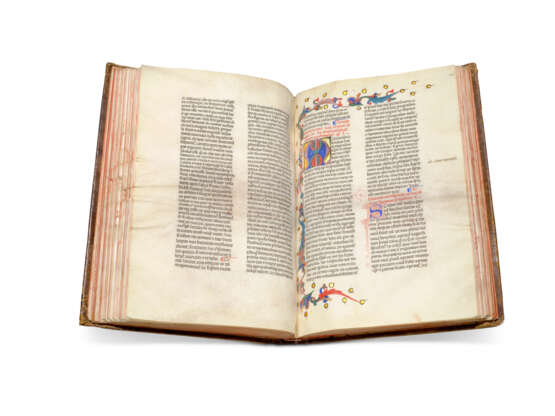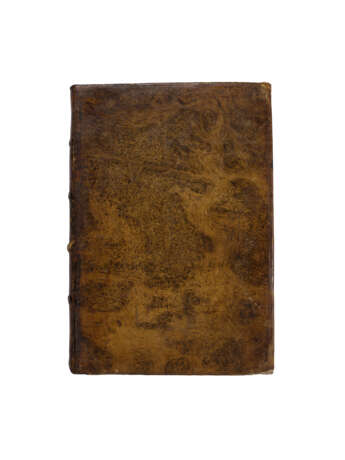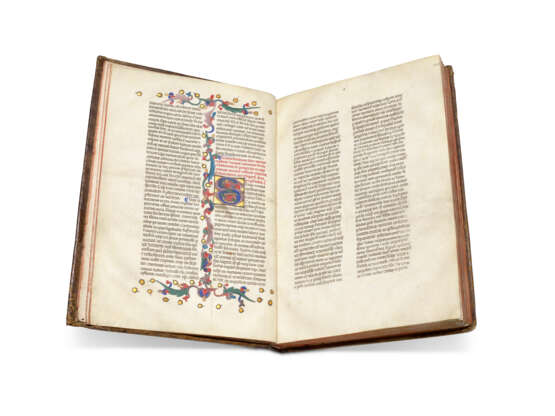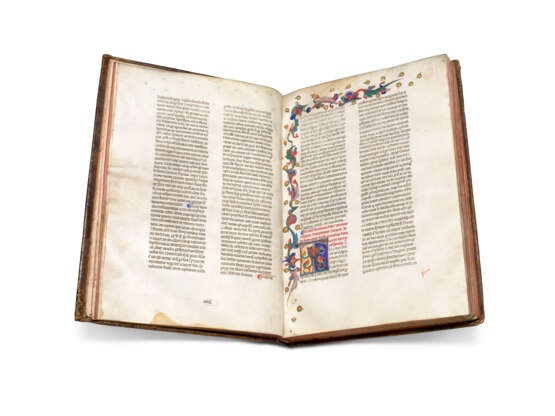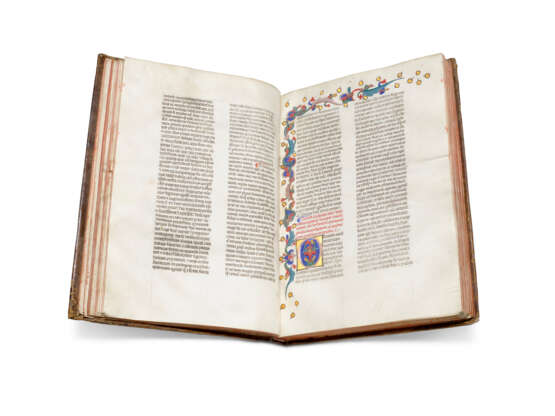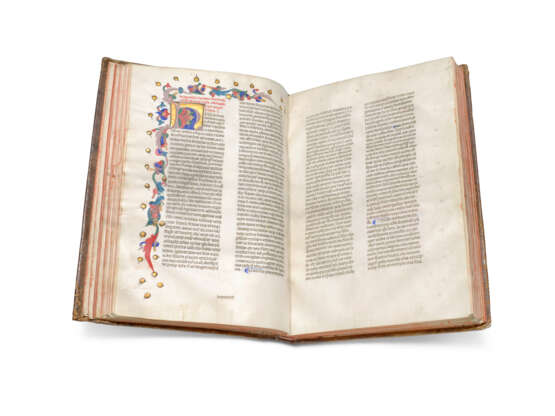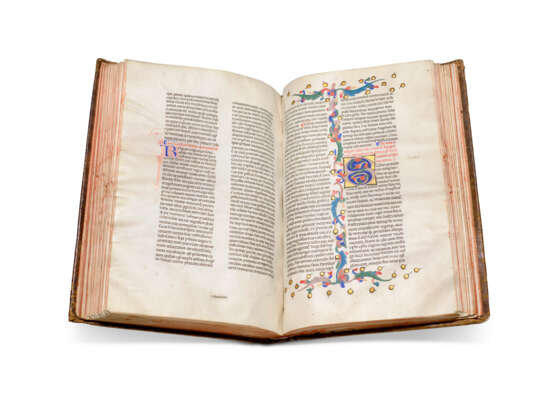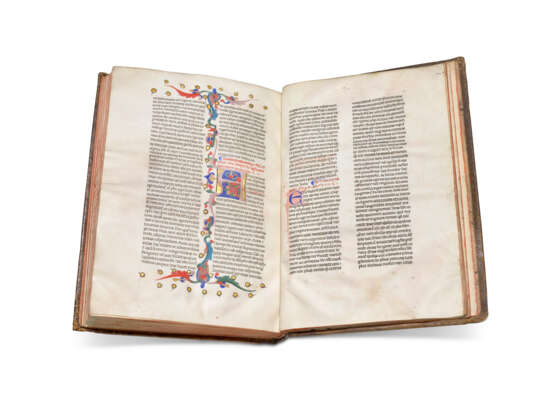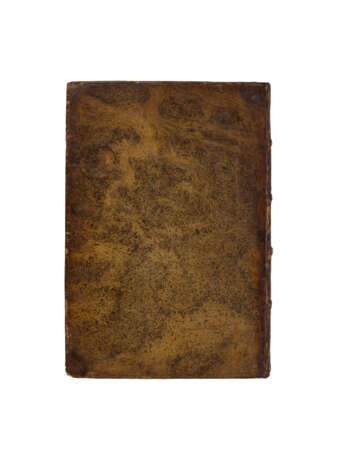ID 1214872
Lot 28 | The Middleton-Fitzhardinge Petrarch
Valeur estimée
£ 40 000 – 60 000
Francesco Petrarca (1304–1374), Epistolae seniles, Books IX–XVII, in Latin, illuminated manuscript on vellum [Northeastern Italy (Padua?), late 14th century]
A large and lavishly illuminated copy of a very rare text by of one of the great figures of Italian literature and founding father of Renaissance humanism, Petrarch, written within 30 years of his death.
340 × 230mm. ii + 100 + ii leaves, collation: 1-1010, with catchwords; two columns of 40 lines, ruled space: 235 × 150mm, written in rounded gothic script, with occasional marginal annotations and maniculae, paraphs in the text alternately red or blue, each letter introduced by a blue paraph, red rubric, and three-line initial in blue with red penwork flourishing, 8 large illuminated initials and foliate borders at the beginnings of books: ff.123v, 141, 155, 170v, 184v, 198, 211, 226v, (the 16th-century ink foliation [121]–130, 141–230 (used here), suggests that 12 gatherings of 10 leaves are lacking at the beginning, another after gathering 1, and one more at the end, stain to first leaf, a few minor blemishes, but overall in good condition with wide clean margins). Bound in a late 18th-century English tree-calf binding, sewn on four bands, the spine with a red leather title-piece lettered in gilt capitals ‘Petracha [sic] Senilivm’, a second black leather label obliterated, marbled endpapers, the edges of the leaves red
Provenance:
(1) Written and illuminated in northeastern Italy, probably Padua or perhaps Venice.
(2) Apparently still complete when foliated in the 16th century, but in its present state in England by the late 18th century, when bound.
(3) John Izard Middleton (1785-1849), of Charleston, South Carolina, and (from 1816) Paris; son of a signer of the Declaration of Independence (on whom see especially S.R. Stebbins, ‘John Izard Middleton: “Talented Enough to Be One of the First Men in America”’, in In Pursuit of Refinement: Charlestonians Abroad, 1740–1860, ed. by M.D. McInnis (Columbia, SC, 1999), pp. 65-86): with his ‘J. J. Middleton’ bookplate (the same bookplate appears in University of Pennsylvania Libraries, MS Codex 303, and Harvard University, Houghton Library, MS Typ 297).
(4) ‘The property of a gentleman who is giving up his London residence’, sold at Sotheby’s, 13 November 1933, lot 14, bought for £9 by:
(5) P.M. Barnard, bookseller of Tunbridge Wells; sold by him in August 1934 to:
(6) James ‘Eric’ Fitzhardinge (1877-1951), of Kurrajong Heights, New South Wales, Australia; thence to his son:
(7) Laurence ‘Laurie’ Frederic Fitzhardinge (1908-1993), Classicist, of the Institute of Advanced Studies, The Australian National University, Canberra; after his death part of his library was donated to the National Library of Australia, Canberra, where it forms The J.L. and L.F. Fitzhardinge Collection (see Margaret Dent, ‘A Man and His Books: The Library of L.F. Fitzhardinge’, National Library of Australia News, 5 (June 1995), pp.6-9); the rest was dispersed, the present MS passing to:
(8) Bernard Quaritch Ltd, Catalogue 1200, Continental Books [1994], no 44; bought in 1994 by:
(9) The Schøyen Collection, MS 1954.
Content:
Petrarch was an enormously prolific writer, and his output includes two collections of his own letters. The better-known, and far more common, is the Epistolae familiares, written between 1325 and 1366; the present collection, the ‘Letters of Old Age’, were written between 1361 and 1374 to recipients including Pope Urban V, Boccaccio, and Emperor Charles IV. Petrarch arranged them into 18 books, of which somewhat less than half are preserved in the present volume. Despite its incomplete state, the volume is important for its early date, having been written within 30 years of the text’s completion and the author’s death.
Despite the obvious interest of the contents, manuscripts are surprisingly rare: none are recorded, for example, in the 8-volume Summary Catalogue of the Bodleian Library, in Ker’s 5-volume catalogue of Medieval Manuscripts in British Libraries, or in de Ricci’s Census of Medieval and Renaissance Manuscripts in North America or its Supplement. The only copy in the Schoenberg database is the present one. The text is edited and translated into English in Francis Petrarch, Letters of Old Age: Rerum senilium libri I–XVIII, by A.S. Bernardo et al., 2 vols (Baltimore, 1992), and a Latin-Italian multi-volume edition is in the course of publication by Silvio Rizzo: Francesco Petrarca, Res seniles (Florence, 2006– ), in which the present manuscript (‘elegantly illuminated’) has the siglum ‘O’.
The first gathering of the manuscript opens in Book IX and breaks off again before the end of Book X: ‘digniore hanc honestet eloquio […] Unum hic antequam’; Books XI–XVII then follow, ending imperfectly: ‘fuisset si vacuus advenisset dixisse […] tam facili apparatu tam nullo [catchword:] fastidio’.
Literature
Manion, M.M., and V.F. Vines, Medieval and Renaissance Manuscripts in Australian Collections (Melbourne, 1984), no. 15 and pl. 13
Manion, M.M., ‘Italian Renaissance manuscripts in Australian collections’, in La miniatura italiana tra gotico e rinascimento, I, ed. by E Sesti (Florence, 1985), pp. 175–88, at 182 and fig. 6
Sinclair, K.V., ‘A New Fragment of Petrarch's Epistolae Seniles’, Speculum, 40 (1965), pp. 323–25
Sinclair, K.V., Descriptive Catalogue of Medieval and Renaissance Western Manuscripts in Australia (Sydney, 1969), pp. 42–43
| Lieu d'origine: | Italie, Europe |
|---|---|
| Catégorie maison de vente aux enchères: | Manuscrits médiévaux et de la Renaissance, Livres et manuscrits |
| Lieu d'origine: | Italie, Europe |
|---|---|
| Catégorie maison de vente aux enchères: | Manuscrits médiévaux et de la Renaissance, Livres et manuscrits |
| Adresse de l'enchère |
CHRISTIE'S 8 King Street, St. James's SW1Y 6QT London Royaume-Uni | |
|---|---|---|
| Aperçu |
| |
| Téléphone | +44 (0)20 7839 9060 | |
| Commission | see on Website | |
| Conditions d'utilisation | Conditions d'utilisation |
